Meta's CTO Andrew Bosworth says Pico 4 UI is "just a knock-off"

Meta's chief technology officer Andrew Bosworth gives his thoughts on competitor Bytedance's first consumer headset in a Q&A session.
Bosworth said what he always says when a competitor enters the fray: That it's good for developers because they have an opportunity to reach more people.
The Pico 4 is a "good headset," but some things look better on paper and are "significantly worse" when you experience them, Bosworth said.
Meta's CTO is amazed at how closely Pico copied Meta's products, especially the user interface. "They say imitation is the highest form of flattery, so I guess I'm flattered," he said. Bosworth believes Pico's user interface is a "knock-off down to the bones".
Still, Bosworth sees Bytedance as a strong competitor, but believes Meta will outperform Pico in terms of quality. Ultimately, the market will decide, says Bosworth.
Meta Quest Pro won't get a passthrough upgrade via software
Bosworth also talks about Meta Quest Pro, which launched this week, citing his personal favorite feature: stereoscopic mixed reality. He said he'd like to see more content for this new form of rendering and can't wait to see what developers do with it.
At the same time, Bosworth emphasizes that the technology is still in its infancy, as Meta only works with two infrared cameras and one color camera so far. One of the biggest criticisms of the first testers is the low quality of the passthrough mode: The digitally reconstructed image of the surroundings is still blurry and grainy.
According to Bosworth, no significant improvement of the Passthrough mode is to be expected, at least for Meta Quest Pro. Only in future generations will Passthrough AR show its true potential, Bosworth says.
Why Meta cut the depth sensor
One key hardware feature that would have supported the device's mixed reality capabilities was dropped by Meta at the last minute: the depth sensor. According to Bosworth, it added cost and weight without adding enough value. It should also enable Meta to make better use of existing sensors, Bosworth says.
What Bosworth doesn't address is that a depth camera would significantly facilitate automatic 3D mapping of the environment, a feature that Meta Quest Pro sorely lacks. Rumor has it that the sensor was dropped due to a broken glass problem.
Apple already showed how a depth scanner can improve automated room scanning in AR tech demos.
Now, the fact that the depth camera is missing from Meta Quest Pro doesn't mean that it won't return in a future device. It's in the nature of building complex hardware to make changes right until the very end, Bosworth said.
Meta's first AR headset likely to come with a pocket computer
Bosworth also addressed the following points during the Q&A session:
- Meta Quest Pro will get the ability to record pass-through videos in color and stream them to secondary screens in a software update.
- Currently, only developers have the option of using the headset's face and eye tracking with a PC.
- The first true AR headset will most likely require a pocket computer for the foreseeable future, he said. Apple's potential advantage is that customers already have one with them (iPhone), so they don't have to carry an additional device with them.
- On whether the Meta Quest Pro's form factor will become standard and find its way into the Meta Quest 3: Bosworth revealed himself to be a fan of the more open form factor and the halo head mount, but he also liked the Meta Quest 2's form factor, namely its portability. Bosworth says consumers will have the final say.
Note: Links to online stores in articles can be so-called affiliate links. If you buy through this link, MIXED receives a commission from the provider. For you the price does not change.